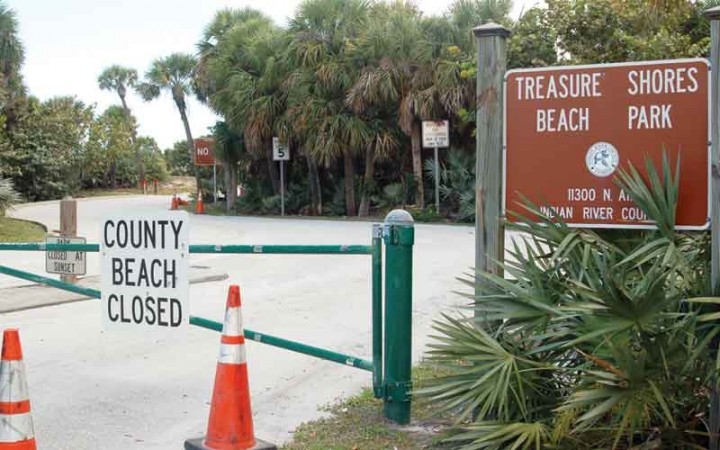
INDIAN RIVER COUNTY — The problem-plagued beach renourishment project on the north end of the barrier island that was supposed to be completed two years ago is again running into problems as contractors missed the deadline to have the sand spread and be off the beach by the March 1 start of turtle-nesting season.
Dump trucks and other equipment used to cart and spread some 5,000 to 6,000 cubic yards of sand sat idle on the badly eroded shoreline after the project skidded to a stop not because of the turtles but because the Fort Pierce contractor, Ranger Construction, ran out of sand Feb. 16.
Officials said they expected work to resume this week.
The project – approaching a $15 million price tag, nearly double the original $7.3 million bid – hit a similar snag last year.
“Here we go again,” said a frustrated James Gray, the county coastal engineer. “After a third go-around on had the material. I want to see this project done so we can move on.”
Patrick Flynn, Ranger’s point man on the project for day-to-day operations, blamed the lack of sand on a few rainy days in February and some other acts of nature such as high tides.
“They’ve run into some bumps in the road,” Flynn said of the sand mine.
Gray, said it never should have come down to rain, as the contractor was told the county wanted all the sand – 108,000 cubic yards of it – ready to go by January when the final phase of the project kicked in again.
Steve Smith, a managing member and an owner of the Ranch Road Lake Sand Mine, Ranger’s subcontractor, said there was no such agreement.
“I respectfully disagree,” he said.
Smith also defended his company, saying crews were working as fast as possible to keep up with the scope of the project and that the only word he gave is that the project will be completed by April 30, when the regulatory permit runs out.
“It’s like any construction project; you cannot control acts of God. There were heavy, heavy rains. It’s nobody’s fault.”
Gray isn’t buying that.
“They had the whole summer to make the sand. The promise and the intention was for it to be done by March 1,” he said.
The project, one of the most ambitious in the state because it uses upland sand rather than sand from the ocean’s floor, will have renourished 6.6 miles of beaches from Treasure Shores to John’s Island with 586,000 cubic yards of sand when it is completed, presumably in the upcoming weeks.
This is the third winter season that crews have carted thousands of truckloads of sand from a mine in the western part of the county over the Wabasso Bridge and spread it on the northern beaches of the barrier island.
Gray said that if the county had gone with more typical way of replenishing a beach, using sand dredged from the ocean, the project in all likelihood would have been completed in time for turtle season in 2010.
The Atlantic Coast turtle season starts March 1.
At least one nest has already been discovered, though north of the project, said Rick Herren, the county’s environmental specialist.
As it stands now, if a nest is discovered within the part of the project once resumes, experts can either try to erect a barrier around the nest or they may be have to move it.
Running out of sand three weeks ago is just one issue dogging the project.
When Ranger was awarded the bid in 2009, the project came with a $7.3 million price tag. Today that cost has more than doubled and tops the $15 million mark.
The notion of using upland sand was one that local contractors had urged for years.
Elected county officials and those in positions of authority felt it was better to keep the money and jobs local, said Chris Mora, the county public works director.
“It was not anyone’s pet project,” he said.
Ranger has a great deal of clout in Florida, and at least in 2009 when it earned the bid from the county, it had a stellar reputation for getting massive public works projects done under budget and ahead of schedule.
“The length of time has been frustrating for us,” said Mora. “But I don’t fault the contractor. I don’t fault anyone. There were delays in the process. … The contractor has been doing a good job.”
Other officials are not rankled by the mushrooming cost and the project’s ever-expanding timeline.
“It’s ahead of schedule,” County Administrator Joe Baird said last week.
When told the work was past the deadline, although still within the permitted window, Baird said: “OK in a perfect world, it would have been done.”
Commissioner Peter O’Bryan isn’t too bothered either.
“I think when all is said and done, we’ll have a great project,” he said.



